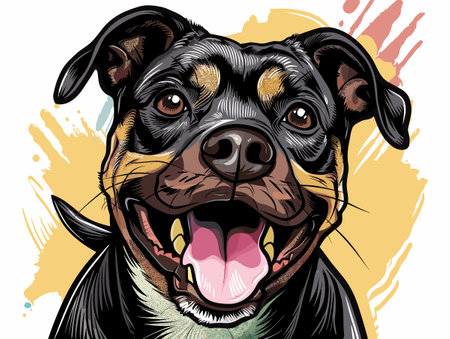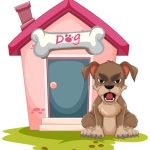1. Understanding the Different Types of Dog Aggression
Dogs can show aggression for various reasons, and understanding these different types can help you identify and manage their behavior more effectively. Here are some common forms of dog aggression:
Fear-Based Aggression
Fear-based aggression occurs when a dog feels threatened or cornered. This type of aggression is often seen in dogs that have had negative experiences or insufficient socialization. Signs include growling, cowering, or snapping when approached.
Territorial Aggression
Some dogs become aggressive when they feel their home or space is being invaded. This type of aggression can manifest when strangers enter the house or approach the yard. Dogs exhibiting territorial aggression may bark excessively, lunge, or even bite to protect their perceived territory.
Possessive Aggression
Also known as resource guarding, possessive aggression happens when a dog becomes overly protective of food, toys, or other objects. They may growl, snap, or bite if someone tries to take away their prized possession.
Redirected Aggression
This occurs when a dog becomes agitated by something but cannot address the source directly, leading them to redirect their frustration onto another person or animal nearby. For example, if two dogs are barking at a passerby through a fence and one turns to bite the other, that’s redirected aggression.
Comparison of Different Types of Dog Aggression
| Aggression Type | Main Trigger | Common Signs | Possible Solutions |
|---|---|---|---|
| Fear-Based | Feeling threatened or cornered | Cowering, growling, snapping | Gradual desensitization, positive reinforcement training |
| Territorial | Protecting home or space | Barking, lunging, biting at intruders | Sustained training and controlled introductions to guests |
| Possessive | Guarding food, toys, or objects | Growling, snapping when approached near possessions | Teaching “drop it” and “leave it” commands with rewards |
| Redirected | Cannot reach intended target of frustration | Biting or attacking nearby people or animals | Avoid high-stress situations and redirect focus with training exercises |
The Importance of Identifying Aggression Early
If you notice any signs of aggression in your dog, it’s important to address them early before they escalate. Understanding the root cause can help you take the right steps toward modifying their behavior in a positive and safe way.
2. Common Triggers of Aggression in Dogs
Understanding why dogs become aggressive is the first step in managing and preventing unwanted behavior. Several common triggers can lead to aggression, including fear, pain, lack of socialization, resource guarding, and past trauma. By identifying these triggers, you can help your dog feel more secure and reduce aggressive tendencies.
Fear-Based Aggression
Dogs often act aggressively when they feel threatened or scared. This type of aggression is usually a defensive reaction to an unfamiliar or intimidating situation. Common fear triggers include loud noises, sudden movements, or encounters with strangers.
Aggression Due to Pain or Discomfort
Pain can make even the most gentle dog react aggressively. If a dog suddenly becomes aggressive without any obvious reason, it may be experiencing discomfort from an injury or medical condition. A visit to the vet can help rule out health-related causes.
Lack of Socialization
Dogs that havent been properly socialized as puppies may struggle to interact with people and other animals. Without early exposure to different environments and experiences, they may respond aggressively out of uncertainty or stress.
Resource Guarding
Some dogs are naturally protective over their food, toys, or personal space. Resource guarding occurs when a dog becomes aggressive when someone approaches their valued possessions. Training and positive reinforcement can help reduce this behavior.
Past Trauma and Negative Experiences
Dogs with a history of abuse or neglect may have deep-seated fears that trigger aggressive responses. Rescue dogs, in particular, might react defensively due to past negative experiences.
Common Triggers and Their Effects
| Trigger | How It Affects Behavior |
|---|---|
| Fear | Barking, growling, lunging at perceived threats |
| Pain or Injury | Aggressive reaction when touched in sensitive areas |
| Lack of Socialization | Anxiety around new people or animals |
| Resource Guarding | Growling or snapping when someone approaches food or toys |
| Past Trauma | Nervousness, avoidance, defensive aggression |
If you notice any of these triggers affecting your dog’s behavior, patience and consistent training can make a big difference. Understanding what causes aggression allows you to create a safer environment for both your pet and those around them.

3. Recognizing Early Warning Signs
Understanding the early warning signs of aggression in dogs is essential for preventing potential issues before they escalate. Dogs communicate their discomfort through both subtle and obvious signals. By recognizing these cues, you can take action to calm your dog and avoid dangerous situations.
Common Body Language Signs
Dogs use their body language to express how they feel. Some signs of discomfort or aggression are easy to notice, while others are more subtle. Here are some key indicators:
| Warning Sign | Description |
|---|---|
| Stiff Posture | The dogs body becomes rigid, with muscles tense and unmoving. |
| Raised Hackles | The fur along the back and neck stands up, signaling heightened alertness or agitation. |
| Tucked Tail | A tail tucked between the legs may indicate fear or stress, which can sometimes lead to defensive aggression. |
| Avoiding Eye Contact | The dog turns its head away or avoids direct eye contact as a way to signal discomfort. |
| Hard Stare | A fixed, intense stare can be a sign that the dog is preparing to react aggressively. |
| Lip Licking or Yawning | These calming signals may indicate anxiety or stress before aggression occurs. |
Vocal Warnings to Watch For
Dogs also use vocalizations to express their emotions. Some sounds can be clear warnings that aggression may follow:
- Growling: A growl is often a dogs way of saying “back off.” It can be a sign of fear, discomfort, or territorial behavior.
- Snarling: When a growl is accompanied by bared teeth, it indicates an increased level of threat.
- Barking: While barking alone isnt always aggressive, rapid, deep-toned barking may indicate heightened arousal or defensive behavior.
- Whining: Whining combined with other body language cues may show frustration or stress that could escalate into aggression.
How to Respond to Early Warning Signs
If you notice any of these warning signs, its important to remain calm and avoid escalating the situation. Here are some quick tips:
- Give Space: Allow the dog room to move away from whatever is causing its distress.
- Avoid Direct Confrontation: Do not stare directly into the dogs eyes or make sudden movements.
- Use a Calm Voice: Speak in a soft, reassuring tone rather than yelling or reacting aggressively yourself.
- Redirect Attention: Offer a distraction such as a toy or treat to shift focus away from the trigger.
- Remove Triggers When Possible: If a certain situation frequently causes tension, try to manage the environment accordingly.
When to Seek Professional Help
If your dog consistently shows warning signs of aggression, it may be time to consult a professional trainer or behaviorist. A certified expert can help identify underlying causes and create a tailored plan for managing your dogs behavior safely and effectively.
Recognizing early warning signs is an essential part of understanding and managing dog aggression. By paying attention to your dogs body language and vocal cues, you can prevent conflicts and ensure a safer environment for both your pet and those around them.
4. Effective Training and Behavior Modification Techniques
Managing dog aggression requires patience, consistency, and the right training techniques. By using positive reinforcement, desensitization, counterconditioning, and professional training approaches, you can help reduce aggressive behavior and create a safer environment for both your dog and those around them.
Positive Reinforcement Strategies
Positive reinforcement focuses on rewarding good behavior rather than punishing bad behavior. This method encourages your dog to repeat desirable actions while reducing fear-based aggression.
- Treat-Based Rewards: Give treats when your dog exhibits calm behavior in situations that usually trigger aggression.
- Praise and Affection: Verbal praise or petting reinforces positive interactions.
- Toy Rewards: Use favorite toys as incentives for good behavior.
Desensitization and Counterconditioning
Desensitization gradually exposes your dog to their triggers in a controlled manner, while counterconditioning helps them associate those triggers with positive experiences.
| Technique | Description |
|---|---|
| Desensitization | Gradually introduce your dog to their trigger at a low intensity, increasing exposure over time while maintaining calm behavior. |
| Counterconditioning | Pair the trigger with something positive (treats or playtime) so your dog learns to associate it with a reward rather than fear or aggression. |
When to Seek Professional Help
If your dogs aggression is severe or difficult to manage, working with a professional trainer or behaviorist can be beneficial. They can provide personalized strategies based on your dogs specific needs.
Types of Professional Training
- Certified Dog Trainers: Help with obedience training and basic behavioral issues.
- Anxiety & Aggression Specialists: Focus on modifying aggressive behaviors through advanced techniques.
- Veterinary Behaviorists: Evaluate medical causes of aggression and may recommend medication if necessary.
The Importance of Consistency
No matter which method you choose, consistency is key. Everyone in the household should follow the same training techniques to ensure clear communication with your dog. Over time, these efforts can lead to noticeable improvements in their behavior.
5. When to Seek Professional Help
Managing dog aggression can be challenging, and in some cases, professional intervention is necessary. While mild behavioral issues can often be addressed with consistent training and positive reinforcement, certain signs indicate that your dog may need the expertise of a professional trainer, behaviorist, or veterinarian.
Signs That Indicate Professional Help Is Needed
If your dogs aggressive behavior becomes frequent, intense, or unpredictable, its time to consider seeking professional assistance. Below are common indicators that suggest your dog requires expert guidance:
| Sign | Description |
|---|---|
| Unprovoked Aggression | Your dog shows aggression without any clear trigger or warning. |
| Biting or Attempting to Bite | Your dog has bitten someone or another animal, even if it didn’t break the skin. |
| Growling or Snapping Frequently | Your dog frequently growls, bares teeth, or snaps at people or other pets. |
| Aggression Escalating Over Time | The aggressive behaviors are becoming more severe or happening more often. |
| Aggression Toward Family Members | Your dog displays aggression toward you, household members, or familiar guests. |
| Anxiety-Driven Aggression | Your dog reacts aggressively due to fear, stress, or anxiety-related triggers. |
| No Response to Training Attempts | Your efforts to manage aggression through training have not improved the behavior. |
The Role of a Professional Trainer vs. Behaviorist vs. Veterinarian
The type of professional you should consult depends on the severity and root cause of your dogs aggression:
Professional Dog Trainer:
- A good option for basic behavioral adjustments and obedience training.
- Suits dogs with mild aggression related to training gaps or lack of boundaries.
- Might not be equipped to handle severe aggression caused by fear or medical conditions.
Certified Animal Behaviorist:
- A specialist in canine behavior who can analyze deep-rooted aggression issues.
- Suits dogs displaying unpredictable, severe, or anxiety-driven aggression.
- Tends to work alongside veterinarians if medical concerns are suspected.
Veterinarian:
- A critical resource if aggression appears suddenly without an obvious reason.
- Suits dogs whose aggression may be linked to pain, neurological issues, or other health concerns.
- Might recommend medical treatment alongside behavioral interventions.
What to Expect from a Professional Evaluation
A professional will assess your dogs history, triggers, and environment before creating a tailored behavior plan. This plan may include desensitization exercises, counter-conditioning techniques, and structured management strategies to help reduce aggressive tendencies safely and effectively.
The Importance of Acting Early
If left unaddressed, aggressive behavior can escalate and become dangerous. Seeking help early improves the chances of successfully managing your dogs aggression while ensuring the safety of both your pet and those around them.
If youre unsure whether professional help is necessary, consulting a veterinarian or certified behaviorist for an initial assessment is always a good step toward finding the best solution for your dogs needs.


